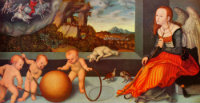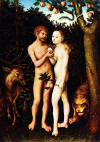Search:: Artists Alphabetically Artists by Country Artists by Century Artists by Movement
Lucas Cranach The Elder
1472-1553
One of the Greatest Painters Of All Time
German
Northern Renaissance Painter, Etcher and Woodblock Printmaker
Education - apprenticed to his father Hans Moller
Cause of death - old age, he was 81
Lucas Cranach was born into a family of creatives. His father was an artist and young Lucas's first art teacher. The artist was a staunch Lutheran and painted numerous portraits of Martin Luther. He became the court painter to the Electors of Saxony and a personal friend to Martin Luther. He quickly gained acclaim for his portraits and imaginative Edens filled with nubile young Eve frolicking with Adam. Distinguished art historian and author, John C. Van Dyke, observed "Lucas Cranach was a Franconian master, who settled in Saxony and was successively court-painter to three Electors and the leader of a small local school there. He, perhaps, studied under Grünewald, but was so positive a character that he showed no strong school influence. His work was fantastic, odd in conception and execution, sometimes ludicrous, and always archaic-looking. His type was rather strained in proportions, not always well drawn, but graceful even when not truthful. This type was carried into all his works, and finally became a mannerism with him. In subject he was religious, mythological, romantic, pastoral, with a preference for the nude figure. In coloring he was at first golden, then brown, and finally cold and somber. The lack of aerial perspective and shadow masses gave his work a queer look, and he was never much of a brushman. His pictures were typical of the time and country, and for that and for their strong individuality they are ranked among the most interesting paintings of the German school. Perhaps his most satisfactory works are his portraits. Lucas Cranach the Younger (1515-1586) was the best of the elder Cranach's pupils. Many of his pictures are attributed to his father. He followed the elder closely, but was a weaker man, with a smoother brush and a more rosy color. Though there were many pupils the school did not go beyond the Cranach family. It began with the father and died with the son."
Like all great painters of his day Cranach was a master of Biblical symbolism. He created fascinating artworks that appealed to the illiterate peasant class as well as rich merchants, clergy, and royalty. His masterpieces contain layers of religious symbolic meaning and at the same time invite the viewer to uncover their own meaning and connection to the artwork. William H. Hunt asserted "When language was not transcendental enough to complete the meaning of a revelation, symbols were relied upon for heavenly teaching, and familiar images, chosen from the known, were made to mirror the unknown spiritual truth."
During his long life Cranach served as a member of the Wittenberg's town council as well as mayor. He became one of the most cherished and wealthiest citizens of Wittenberg and lived a long productive life, painting until his eyesight failed. The great artist passed away at the age of be 81. The newly emerging painting techniques and styles were a reflection of the transformation that was taking place in Europe, the change from the medieval period to a more enlightened, tolerant society. According to Historian Hendrik van Loon, "People were tremendously alive. Great states were being founded. Large centres of commerce were being developed. High above the turreted towers of the castle and the peaked roof of the town-hall, rose the slender spire of the newly built Gothic cathedral. Everywhere the world was in motion. The high and mighty gentlemen of the city-hall, who had just become conscious of their own strength (by way of their recently acquired riches) were struggling for more power with their feudal masters."The Renaissance marks the ascendancy of individualism and the uncompromising prominence of the individual. Artists of the Renaissance were raised up in social standing and their artworks was no longer looked upon as simple handicrafts, but as divinely inspired creations. Distinguished art historian and author, John C. Van Dyke, observed "The word "Renaissance" has a broader meaning than its strict etymology would imply. It was a "new birth," but something more than the revival of Greek learning and the study of nature entered into it. It was the grand consummation of Italian intelligence in many departments—the arrival at maturity of the Christian trained mind tempered by the philosophy of Greece, and the knowledge of the actual world. Fully aroused at last, the Italian intellect became inquisitive, inventive, scientific, skeptical—yes, treacherous, immoral, polluted. It questioned all things, doubted where it pleased, saturated itself with crime, corruption, and sensuality, yet bowed at the shrine of the beautiful and knelt at the altar of Christianity. It is an illustration of the contradictions that may exist when the intellectual, the religious, and the moral are brought together, with the intellectual in predominance.
Important Words, People, Phrases, Chactoristics related to the Northern Renaissance Art Movement - allegorical painting, rebirth, 1 point perspective, Hieronymus Bosch, Limbourg Brothers, Robert Campin, Jan Van Eyck, Jean Fouquet, formation of a merchant class, glazing, impasto, scriptorium, illuminator, invention of the printing press, woodcuts, engravings, Antwerp, commerce, Northern Europe, Bruges, mythological scenes, genre painting, landscapes, portraits, moralizing overtones, human vices, lust, Protestant Reformation, paradise, spirituality, piousness, living a simple life, reform, Human Reasoning, merchant class at work, idyllic scenes of peasants, playing games, feasting, linear perspective, Heliocentric Theory, spiritually significant, illuminated manuscript, idealized biblical themes, scriptorium, emotion, illuminator, iconoclast, Age of Discovery, Virgin and Child, axonometric drawing, curiosity about the natural world, realistic use of colours and light, Bonfire of the Vanities, Old Testament stories, Gospel parables, The Blackdeath, Christian symbolism
☼☼☼☼☼
Important Northern Renaissance Artists
Hieronymus
Bosch (1453
- 1516) Dutch
Dieric
Bouts the Elder (1413-1475) Dutch
Pieter
Brueghel the Elder (1525
- 1569) Flemish
Pieter
Brueghel the Younger (1564
- 1638) Flemish
Lucas
Cranach the Elder (1472
- 1553) German
Albrecht
Dürer (1471
- 1528) German
Matthias
Grünewald (1434-1494) Flemish
Hans
Holbein the Younger (1497-1543) German
Quentin
Massys (1466–1530 Flemish, Northern
Renaissance
Rogier
van der Weyden (1399-1464) Dutch
Jan
van Eyck (1385
- 1441) Flemish
Require more facts and information about the painter and the artists of the Northern Renaissance era? Poke around every nook and cranny of the known universe for information this subject. Search Here
© HistoryofPainters.com If you like this page and wish to share it, you are welcome to link to it, with our thanks.

